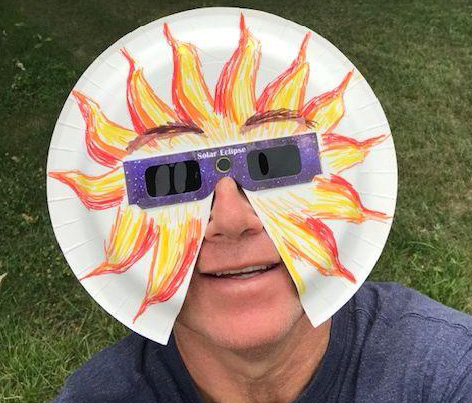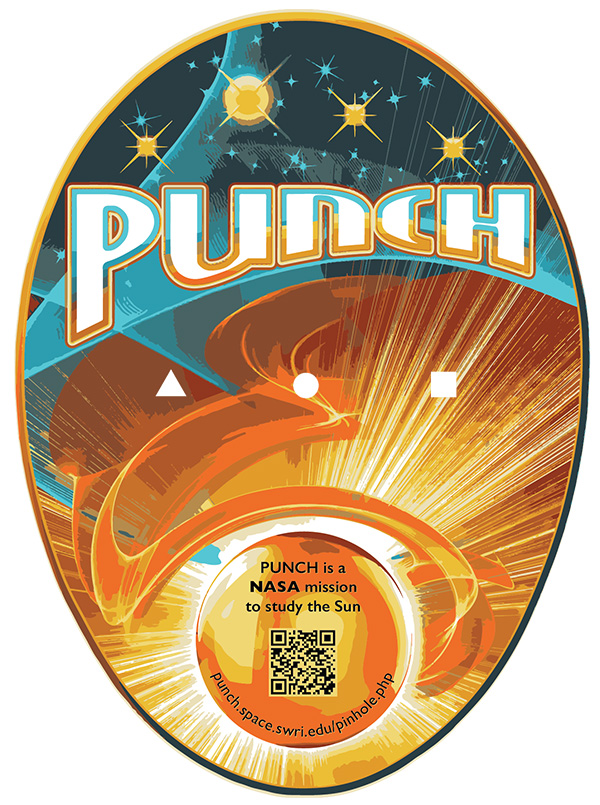The solar eclipse of April 8, 2024, is the perfect opportunity to get people of all ages interested in the wonder of eclipses through art and science. Here are some activities that anyone with even a passing interest can get involved in — especially families with children.
Ages 3 and Up: Eclipse Masks and Corona Art
Eclipse Paper Masks
Parents and guardians can assist kids with cutting out a space for their ISO 12312-2 solar glasses. Kids can then decorate their new paper-plate masks to look like their favorite character, superhero, or anything their imaginations dream of! These masks can be made in advance of the eclipse, stressing the importance of eye safety to even the youngest of learners. Masks can then be stored away afterwards for additional solar viewing opportunities.
- ISO 12312-2–approved solar-viewing glasses
- Paper plates
- Craft or utility knife
- Clear tape
- Pencil or pen for tracing the glasses onto the plate
- Markers or paint for decoration

You can find the full instructions from NASA Data here.
Corona Art

Petroglyph: Chaco Culture National Historical Park; Photo: NASA / Aubrey Gemignani
Solar eclipses have been imaged across centuries, and this one will be no different. You can instruct kids as young as three about the solar corona using an image of the Sun during totality (like above) for reference, black construction paper, and chalk.
- Chalk (bright colors)
- Black construction paper
- Circular item to trace
On your paper, trace a circle using a round-rimmed cup to represent the edge of the Sun being covered by the Moon. Then, referring to your image of the Sun during totality, have kids produce their own interpretation of the corona using light colored chalk, so it stands out against the paper.
If you’re in the path, after the event, you can compare your corona art to the solar corona during totality — are there any similarities?
Eclipses Around the World
Share eclipse tellings from other cultures with the Astronomical Society of the Pacific's Ways of Knowing: Eclipses Around the World activity. This collection illustrates how eclipses have been interpreted throughout the ages, from a giant frog swallowing the Sun to a giant dog stealing it! This can be downloaded in PDF, PowerPoint, or Google Slides format.
Ages 7 and Up: Pinhole Cameras
Pinhole Camera
A slightly more advanced craft activity would be a pinhole camera. Kids should be able to make these items on their own with parental supervision. These can be made several ways, but today we’ll go with the box method.

Katherine Troche
Materials:
- Box
- Scissors
- Clear tape
- Aluminum foil
- Sheet of paper
- Sharp object (push pin, needle, etc.)
You can use a box of any size, and you can decorate it to be on theme with the day! By using these simple household items, you can safely view the eclipse. You can find a video with these steps on NASA Goddard’s YouTube channel.
Note: When you use pinhole projection, the Sun will be behind you; you will not be looking at it directly.
PUNCH Cards
If you want a pinhole projector that is slightly more mind-blowing, visit the Polarimeter to UNify the Corona and Heliosphere — or PUNCH — mission website. Here, you can learn more about the mission to study solar winds and download their three-hole-punch template. Once you print your PUNCH card, you will need a craft knife to gently cut the triangle, square and circle shape out from the card. These cards, which come in English and Spanish, explain how light behaves regardless of the shape of your pinhole.
Note: When you use pinhole projection, the Sun will be behind you; you will not be looking at it directly.

Ages 11 and Up: Citizen Science
Older kids and adults can participate in citizen-science projects if they have a smartphone available. At NASA’s Eclipses & Citizen Science page, there are several projects to choose from, but here are three to highlight:
GLOBE Eclipse
GLOBE Eclipse is a tool within the GLOBE Observer app that will allow you to measure air temperature and clouds during the eclipse. You can download this free app and help contribute data to the GLOBE program. The app will also allow you to participate in other data collection, such as measuring mosquito habitats and land coverage. Learn more at https://observer.globe.gov/
Eclipse Soundscapes
Led by ARISA Lab, Eclipse Soundscapes will compare data from a 1932 study on how eclipses affect wildlife, such as crickets. There are a number of ways you can participate, from being an observer during the eclipse to being a facilitator and leading a group of soundscape enthusiasts! Learn more at https://eclipsesoundscapes.org/
The LightSound Project
Since 2017, the LightSound Project has worked with the Blind and Low Vision community to develop the LightSound box — a small device that converts light intensity into sound. Instructions on how to build your own LightSound box can be found in English, Spanish, and French, or you can request a pre-built box while supplies last. Learn more at https://astrolab.fas.harvard.edu/LightSound.html#about
This eclipse will be the last one in the contiguous United States for the next two decades. One of the best ways you can celebrate it with younger generations is by fostering a lifelong love of science. I hope you have the clearest of skies for April 8th. Keep (safely) looking up!
Find more information and resources for the 2024 solar eclipse.
 0
0








Comments
You must be logged in to post a comment.